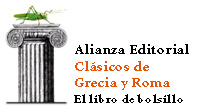¿Cuándo remiten a un evento y cuándo a un resultado los sustantivos deverbales en -tio del latín?When do Latin deverbal nouns in -tio refer to an event and when to a result?
Eveling Garzón Fontalvo
Resumen
Este artículo parte de la descripción del continuum existente entre las categorías universales de Nombre y Verbo, en el que los sustantivos deverbales ocupan una posición intermedia (§ 1). A continuación, se presenta el problema de la doble interpretación, a veces como evento a veces como resultado, de algunos sustantivos deverbales en las lenguas clásicas. Para intentar dilucidar esta cuestión, este estudio sobre algunos derivados latinos en –tio -tionis propone una explicación basada en el grado de afectación que experimenta el objeto de sus verbos de base (§ 2). En última instancia, este trabajo pretende mostrar que las nuevas perspectivas de análisis pueden arrojar luz sobre cuestiones aún no resueltas.
Palabras clave: sustantivos deverbales; afectación; sustantivos de evento; sustantivos de resultado
Abstract
This article starts with a description of the continuum between the universal categories Noun and Verb, in which deverbal nouns demonstrably occupy an intermediate position (§ 1). Then, it tackles the problem as to why some deverbal nouns in classical languages, specifically some Latin derivatives in –tio -tionis, admit of the double reading, either as an event or as a result. Arguably, the crucial factor is the degree of affectedness experienced by the object of their base verbs (§ 2). Ultimately, this paper aims to show that new perspectives of analysis can shed light on traditionally problematic issues.
Keywords: deverbal nouns; affectedness; event nouns; result nouns
Referencias bibliográficas
BEAVERS, J. (2011) «On Affectedness», Natural Language & Linguistic Theory 29 (2), 335-370.
BEAVERS, J. (2013) «Aspectual Classes and Scales of Change», Linguistics 51 (4), 681-706.
BEAVERS, J. y KOONTZ-GARBODEN, A (2017) «Results Verbs, Scalar Change, and the Typology of Motion Verbs», Language 93 (4), 842-876.
COMRIE, B. y THOMPSON, S.A. (2007) «Lexical Nominalization», en T. Shopen (ed.), Language Typology and Syntactic Description, Cambridge, Cambridge University Press, 334-381.
DRESSLER, W. U. (1986) «Explanation in Natural Morphology, Illustrated with Comparative and Agent-Noun Formation», Linguistics 24, 519-548.
ESCANDELL, M.V. (1995) Los complementos del nombre, Madrid, Arco Libros.
HOPPER, P. J. y THOMPSON, S.A. (1980) «Transitivity in Grammar and Discourse», Language 56 (2), 251-299.
HOPPER, P. J. y THOMPSON, S.A. (1985) «The Iconicity of the Universal Categories ‘Noun’ and ‘Verb’», en J. Haiman (ed.), Iconicity in Syntax: Proceedings of a Symposium on Iconicity in Syntax, Stanford, June 24-6, 1983, Ámsterdam/Filadelfia, John Benjamins.
GARZÓN, E. (2018) Nombres de Acción y otros derivados deverbativos en latín, Tesis doctoral, Madrid, Universidad Autónoma de Madrid.
GARZÓN, E. (2020) «Latin Verbal Nouns in –tio: Interpretations and Selection Restrictions», Lingue Antiche e Moderne9, 87-105, DOI: 10.4424/lam92020-4.
MELLONI, Ch. (2011) Event and Result Nominals. A Morpho-semantic Approach, Berna, Peter Lang.
VILLA, DE LA J. (2020) «Lexical and Syntactic Constrictions for the Derivation of Verbal Nouns in -τις / -σις», en M. Leiwo, M. Vierros y S. Dahlgren (eds.), Papers on Ancient Greek Linguistics: Proceedings of the Ninth International Colloquium on Ancient Greek Linguistics (ICAGL 9), 30 August – 1 September 2018, Helsinki (Commentationes Humanarum Litterarum 139), Helsinki, Societas Scientiarum Fennica, 403-416.
Revista
-
Sobre la revista
Página principal
-
Estatutos
Estatutos de la Revista Estudios Clásicos
-
Código ético
Declaración de buenas prácticas
-
Normas de recepción y envío
Indicaciones para envíos de artículos
-
Equipo editorial
Consejos de redacción y asesor
-
Comité de honor
Comité de honor
Información
-
Para autores
Publicar con nosotros
-
Para evaluadores
Normas para evaluar artículos
-
Para bibliotecas
Información bibliográfica
-
Contacto
Cuestiones y preguntas
Publicar en EClás
-
Envío de originales
Artículos y reseñas
-
Normas de publicación
Descarga normas en PDF
-
Estilo CSL EClás
Estilo CSL EClás
-
Índices de calidad
Bases de datos e impactos


 c/ Serrano, 107
c/ Serrano, 107